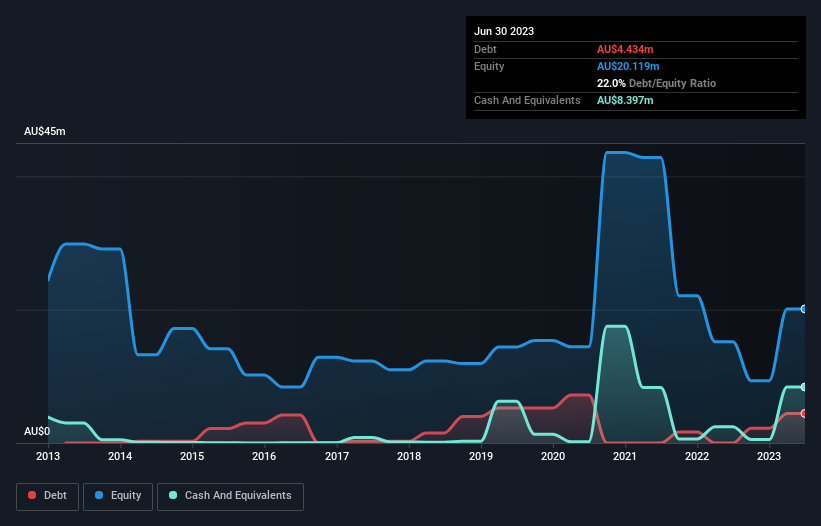
David Iben put it well when he said, 'Volatility is not a risk we care about. What we care about is avoiding the permanent loss of capital.' When we think about how risky a company is, we always like to look at its use of debt, since debt overload can lead to ruin. We can see that Sihayo Gold Limited (ASX:SIH) does use debt in its business. But is this debt a concern to shareholders?
What Risk Does Debt Bring?
Generally speaking, debt only becomes a real problem when a company can't easily pay it off, either by raising capital or with its own cash flow. Ultimately, if the company can't fulfill its legal obligations to repay debt, shareholders could walk away with nothing. However, a more usual (but still expensive) situation is where a company must dilute shareholders at a cheap share price simply to get debt under control. Of course, debt can be an important tool in businesses, particularly capital heavy businesses. The first thing to do when considering how much debt a business uses is to look at its cash and debt together.
Check out our latest analysis for Sihayo Gold
What Is Sihayo Gold's Debt?
As you can see below, at the end of June 2023, Sihayo Gold had AU$4.43m of debt, up from none a year ago. Click the image for more detail. However, its balance sheet shows it holds AU$8.40m in cash, so it actually has AU$3.96m net cash.

How Strong Is Sihayo Gold's Balance Sheet?
Zooming in on the latest balance sheet data, we can see that Sihayo Gold had liabilities of AU$11.8m due within 12 months and liabilities of AU$993.8k due beyond that. On the other hand, it had cash of AU$8.40m and AU$79.8k worth of receivables due within a year. So its liabilities outweigh the sum of its cash and (near-term) receivables by AU$4.27m.
This deficit isn't so bad because Sihayo Gold is worth AU$18.3m, and thus could probably raise enough capital to shore up its balance sheet, if the need arose. However, it is still worthwhile taking a close look at its ability to pay off debt. Despite its noteworthy liabilities, Sihayo Gold boasts net cash, so it's fair to say it does not have a heavy debt load! When analysing debt levels, the balance sheet is the obvious place to start. But it is Sihayo Gold's earnings that will influence how the balance sheet holds up in the future. So when considering debt, it's definitely worth looking at the earnings trend. Click here for an interactive snapshot.
Given its lack of meaningful operating revenue, investors are probably hoping that Sihayo Gold finds some valuable resources, before it runs out of money.
So How Risky Is Sihayo Gold?
By their very nature companies that are losing money are more risky than those with a long history of profitability. And the fact is that over the last twelve months Sihayo Gold lost money at the earnings before interest and tax (EBIT) line. Indeed, in that time it burnt through AU$8.1m of cash and made a loss of AU$8.9m. Given it only has net cash of AU$3.96m, the company may need to raise more capital if it doesn't reach break-even soon. Summing up, we're a little skeptical of this one, as it seems fairly risky in the absence of free cashflow. When analysing debt levels, the balance sheet is the obvious place to start. But ultimately, every company can contain risks that exist outside of the balance sheet. These risks can be hard to spot. Every company has them, and we've spotted 6 warning signs for Sihayo Gold (of which 5 are concerning!) you should know about.
At the end of the day, it's often better to focus on companies that are free from net debt. You can access our special list of such companies (all with a track record of profit growth). It's free.
If you're looking to trade Sihayo Gold, open an account with the lowest-cost platform trusted by professionals, Interactive Brokers.
With clients in over 200 countries and territories, and access to 160 markets, IBKR lets you trade stocks, options, futures, forex, bonds and funds from a single integrated account.
Enjoy no hidden fees, no account minimums, and FX conversion rates as low as 0.03%, far better than what most brokers offer.
Sponsored ContentNew: Manage All Your Stock Portfolios in One Place
We've created the ultimate portfolio companion for stock investors, and it's free.
• Connect an unlimited number of Portfolios and see your total in one currency
• Be alerted to new Warning Signs or Risks via email or mobile
• Track the Fair Value of your stocks
Have feedback on this article? Concerned about the content? Get in touch with us directly. Alternatively, email editorial-team (at) simplywallst.com.
This article by Simply Wall St is general in nature. We provide commentary based on historical data and analyst forecasts only using an unbiased methodology and our articles are not intended to be financial advice. It does not constitute a recommendation to buy or sell any stock, and does not take account of your objectives, or your financial situation. We aim to bring you long-term focused analysis driven by fundamental data. Note that our analysis may not factor in the latest price-sensitive company announcements or qualitative material. Simply Wall St has no position in any stocks mentioned.
About ASX:SIH
Sihayo Gold
Engages in the exploration and development of mineral resources primarily in Indonesia.
Moderate with mediocre balance sheet.
Market Insights
Community Narratives




